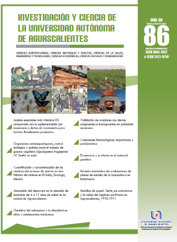Entomological collections: relevance and problems
DOI:
https://doi.org/10.33064/iycuaa2022863624Keywords:
insects, scientific collections, biodiversity, Importance of collections, collection problemsAbstract
Entomological collections house insect specimens and are part of the natural history collections. They are important to generate knowledge about different aspects of the most numerous biological groups in species on the planet. In this work, two relevant aspects of entomological collections are highlighted: their importance in different fields of knowledge and culture, and the problems they face in their existence and functionality. It is expected that the dissemination of the addressed topic, would contribute to the search for ways of solving the problems that scientific collections face, particularly those found in developing countries which also count with great biodiversity.
Downloads
References
• Aldaroso-Maya, E. M., & Argueta-Villamar, A. (2013). Colecciones EtnoEntomológicas comunitarias: Una propuesta conceptual y metodológica. Etnobiología, 11(2), 1-15.
• Álvarez-Gómez, S. M., González-Arteaga, J., & Pinto-Zárate, J. (2021). Protocolo de manejo. Colección Entomológica María Sibylla Merian (CEMS). Versión 1 (2021-08-01). Bogotá: Colección Entomológica María Sibylla Merian, Grupo de Investigación Biota y Sociedad, Fundación Trópico Alto, Red de Reservas Naturales del Trópico Alto. doi: 10.13140/RG.2.2.22729.88161.
• Balke, M., Schmidt, S., Hausmann, A., Toussaint, E., Bergsten, J., Buffington, M., Häuser, …, & Hobern, D. (2013). Biodiversity into your hands - A call for a virtual global natural history ‘metacollection’. Frontiers in Zoology, 10, 1-9. http://www.frontiersinzoology.com/content/10/1/55
• Chalmers, N., Carter, D., & Walker, A. (1999). Foreword and prefaces. En: D. Carter & A. Walker (Eds). Care and conservation of Natural History Collections (pp. i-xxi). Oxford: Butterwoth Heinemann. URL: http://www.natsca.org/care-and-conservation
• Colvin, M. (2014). Entomological collections - Their historic importance and relevance in the 21st century. Recuperado de: http://www.dispar.org/reference.php?id=92.
• Comisión Nacional para el Conocimiento y Uso de la Biodiversidad (CONABIO). (2016). Colecciones biológicas científicas de México. CONABIO. Recuperado de: www.biodiversidad.gob.mx/especies/colecciones
• Crisci, J. V., & Katinas, L. (2017). El fin de las colecciones de Historia Natural en un tiempo de extinciones. En: Comité Académico sobre conservación de humedales Latinoamericanos (Ed.). Taller sobre “Conservación del patrimonio natural y cultural, conceptos básicos y definiciones” (pp. 80-96). Buenos Aires: Estudios de la Academia Nacional de Ciencias de Buenos Aires.
• Cristín, A., & Perrilliat, M. del C. (2011). Las colecciones científicas y la protección del patrimonio paleontológico. Boletín de la Sociedad Geológica Mexicana, 63(3), 421-427.
• Dooley, J. W., & Smith-Pardo, A. H. (2013). Value of entomological collections in the study of biodiversity: Examples from the collection of hard scales (Hemiptera: Diaspididae), whiteflies (Hemiptera: Aleyrodidae) and sweat bees (Hymenoptera: Halictidae) at the California Academy of Science. Boletín del Museo Entomológico Francisco Luís Gallego, 5(3), 7-15.
• Gutiérrez, E. E., & Pine, R. H. (2017). Specimen collection crucial to taxonomy. Science, 355(6331), 1275. doi: 10.1126/science.aan0926
• International Commission on Zoological Nomenclature (ICZN). (1999). International Code of Zoological Nomenclature (4a ed.). London: International Trust of Zoological Nomenclature.
• Llorente–Bousquets, J. E., & Castro–Gerardino, D. J. (2002). Colecciones entomológicas en instituciones taxonómicas de Iberoamérica: ¿Hacia estrategias para el inventario de la biodiversidad? En: J. Llorente-Bousquets & C. Costa (Coords.). VI Museos y Colecciones de Historia Natural (pp. 307–318). Zaragoza: Sociedad Entomológica Aragonesa – Prigrama Iberoamericano de Ciencia y Tecnología para el Desarrollo.
• Márquez, J. (2005). Técnicas de colecta y preservación de insectos. Boletín Sociedad Entomológica Aragonesa, 37, 385-408.
• Martín-Albaladejo, C. (2014). El Museo Nacional de Ciencias Naturales y la enseñanza de las Ciencias de la Naturaleza en España: Las colecciones como herramienta didáctica. Boletín de la Real Sociedad Española de Historia Natural, Sección Biología, 108, 1-17.
• Paknia, O., Rajaei, H., & Koch, A. (2015). Lack of well-maintained natural history collections and taxonomists in megadiverse developing countries hampers global biodiversity exploration. Organisms Diversity & Evolution, 15, 619-629. doi: 10.1007/s13127-015-0202-1
• Ponder, W. F., Carter, G. A., Flemons, P., & Chapman, R. R. (2001). Evaluation of museum collection data for use in biodiversity assessment. Conservation Biology, 15(3), 648-657.
• Secretaría de Medio Ambiente y Recursos Naturales (SEMARNAT). (s. f.). Trámite SEMARNAT-08-049-A. SEMARNAT. Recuperado de: https://www.gob.mx/semarnat/documentos/tramite-semarnat-08-049-a
• Shaffer, H. B., Fisher, R. N., & Davidson, C. (1998). The role of natural history collections in documenting species declines. Tree, 13(1), 27-30.
• Smith, V. S., & Blagoderov, V. (2012). Bringing collections out of the dark. ZooKeys, 209, 1-6. doi: 10.3897/zookeys.209.3699
• Short, A. E. Z., Dicow, T., & Moreau, C. S. 2018. Entomological collections in the age of big data. Annual Review of Entomology, 63(1), 513-530.
• Suarez, A. V., & Tsutsui, N. D. (2004). The value of museum collections for research and society. BioScience, 54(1), 66-74.
• Sutrisno, H. (2012). The impact of storage times of museum insect specimens on PCR success: case study on moth collections in Indonesia. Journal of Biosciences, 19(2), 99-104.
• Ward, D. F. (2012). More than just records: Analysing Natural History Collections for biodiversity planning. PLoS ONE, 7(11), e50346. doi:10.1371/journal.pone.0050346
• Zhang, Z. Q. (2013). Phylum Arthropoda. Zootaxa, 3703(1), 17-26.
Downloads
Published
How to Cite
License
Copyright (c) 2022 Juan Márquez-Luna, Norma L. Manríquez-Morán, Jesús Martín Castillo-Cerón, Irene Goyenechea

This work is licensed under a Creative Commons Attribution-NonCommercial-ShareAlike 4.0 International License.
Las obras publicadas en versión electrónica de la revista están bajo la licencia Creative Commons Atribución-NoComercial-CompartirIgual 4.0 Internacional (CC BY-NC-SA 4.0)









